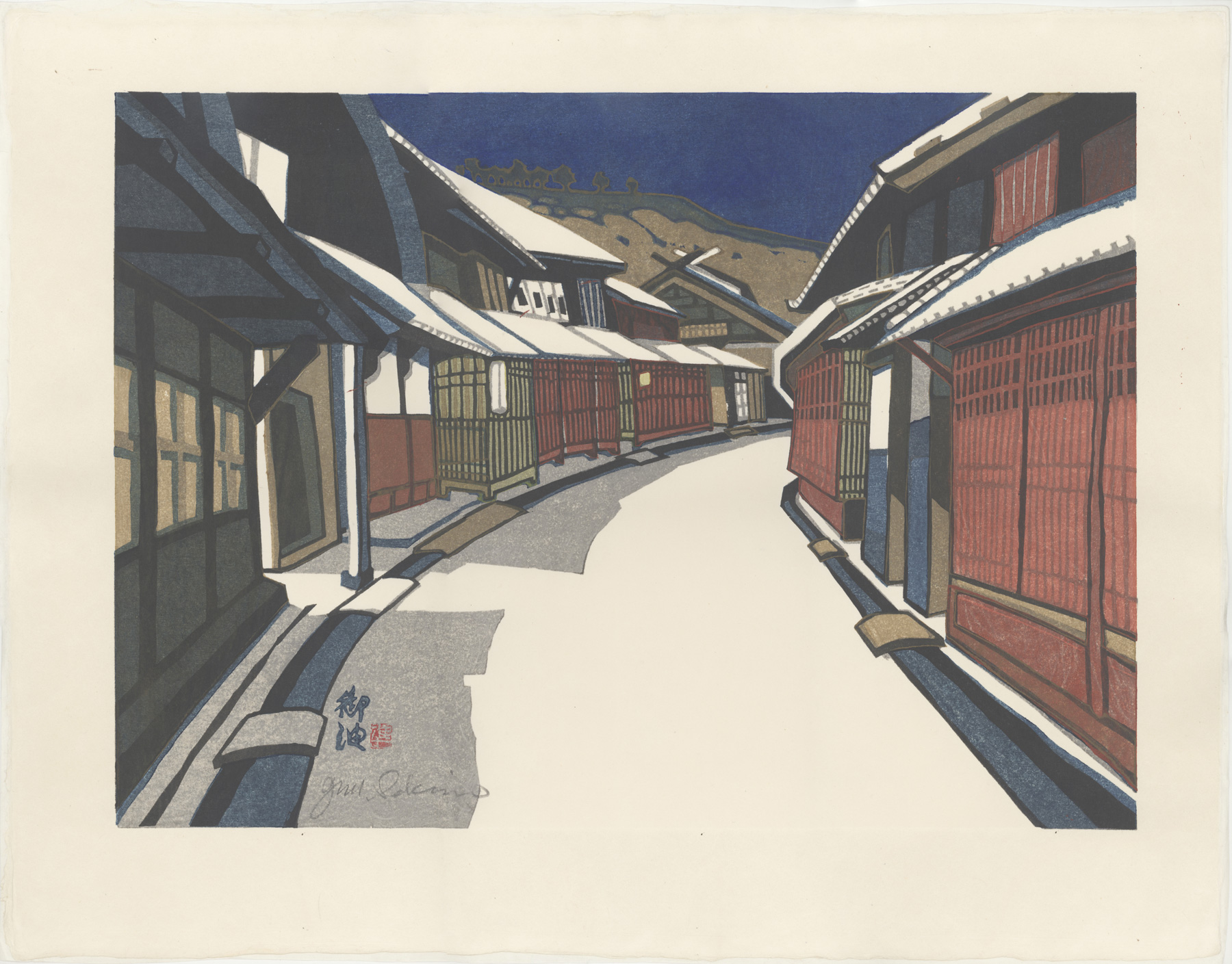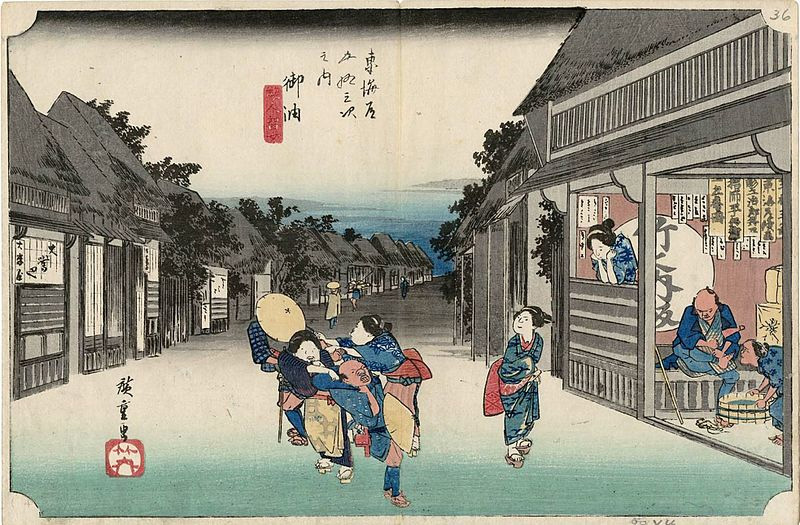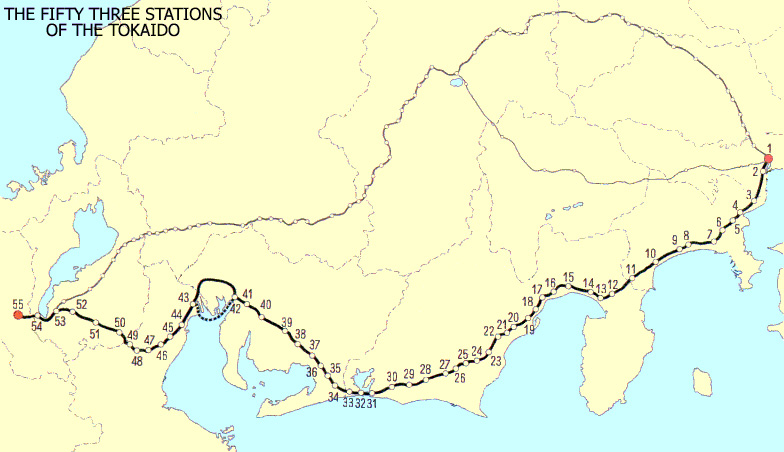About This Print
Sekino's Goyu is devoid of people in his evening scene of the thirty-sixth station along the Tōkaidō (the "Eastern Sea Route") running from Tokyo to Kyoto. The print is the 35th, in chronological order, of 55 prints Sekino created for his modern version of the series Fifty-Three Stations of the Tōkaidō.Source: Woodblock Prints by Sekino Jun'ichirō: The Fifty-Three Stations of The Tōkaidō, Robert McClain, Visual Arts Resources, Museum of Art, University of Oregon, 1978.
36. Goyu: Scarlett Latticework
August 1969 (35)
Goyu is bypassed by the modern Tōkaidō highway, leaving the houses and shops lining both sides of the street much as in Hiroshige's day. It is said that during the Edo Period Goyu had a dubious reputation as a town where persistent young waitresses enticed travelers into the inns and also doubled as prostitutes.
While the composition of Sekino's print of Goyu compares closely to Hiroshige's, the subjects are quite dissimilar. Hiroshige depicted the comic travelers and waitresses of Goyu, but Sekino's scene is deserted and quiet and focuses on the architecture and loneliness. The subtitle "Scarlet Latticework" refers to the lightweight but strongly fashioned wooden lattice screens, kōshi, which take on a reddish tone with age.
The Hiroshige Print from his Hōeidō edition (1833–1834) of Fifty-Three Stations of the Tōkaidō
Sekino's Fifty Three Stations of the Tōkaidō
Source: Modern Japanese Woodblock Prints - The Early Years, Helen Merritt, University of Hawaii Press, 1998, p.241-242 and Guide to Modern Japanese Woodblock Prints: 1900-1975, Helen Merritt, University of Hawaii Press, 1992, p. 259-260.
"In 1959 Sekino started a series of prints of the Fifty-Three Stations of the Tōkaidō (Eastern Sea Road.) He returned each year, sketching for a few more stations, until the entire series was complete in 1974.... In 1975, after the completion of the modern Tōkaidō series, the Ministry of Education Award was granted to Sekinō because of his outstanding achievement 'in using every possible technique in woodblock printing, Japanese traditional art, and the recreation of the old fifty-three stations on the Tōkaidō highway in a present-day light.'"In the Artist's Words
Source: Sekino Jun'ichirō hanga sakuhin shū 關野準一郎版画作品集 [Jun-ichiro Sekino The Prints], Sekino, Abe Shuppansha, 1997, p. 11.
...in 1958, after my trip to America and Europe for a year, I decided that I should produce a series of prints of the fifty three stations. But I intended to create it rather behind the public. I sketched, composed the charms along the "Highways", seasonal events, wanderings, using my own interpretation. I could produce at most only four pieces annually in between the creation for the regular exhibitions..."
After fifteen years,
I finally finished the
Fifty-three stations
Of the Tokaidō series;
Admiring them, I caught cold.
- Sekinō Juni'chiro, 1974, upon completion of the series
After fifteen years,
I finally finished the
Fifty-three stations
Of the Tokaidō series;
Admiring them, I caught cold.
- Sekino Juni'chirō, 1974, upon completion of the series
List of Prints in the Series
1. Nihonbashi: Expressway, July 1960
2. Shinagawa: Tokyo Tower, July 1960
3. Kawasaki: Tama River, Dec. 1960
4. Kanagawa: Foreigners Cemetery, Jan 1971
5. Hodgaya: 1942 Steam Engine No. D51, Jan. 1969
6. Totsuka: Carp Streamers, May 1963
7. Fujisawa: Pampas Grass Road, Jan. 1961
8. Hiratsuka: Star Festival in July, Aug. 1961
9. Ōiso: Harvest Season, June 1960
10. Odawara: Daruma Market, June 1960
11. Hakone: Mt. Fuji over the Lake, May 1974
12. Mishima: Mishima Shrine, Dec. 1969
13. Numazu: Latticework Tile Wall, Feb. 1964
14. Hara: Roof-Tile Reflection of Mt. Fuji, Oct. 1964
15. Yoshiwara: Mt. Fuji and Cherry Blossoms, May 1974
16. Kanbara: Deep Snow, July 1973
17. Yui: Mt. Fuji Through the Window, June 1967
18. Okitsu: View from Seiken-ji, Apr. 1974
19. Ejiri: Shimizu Port, Aug. 1972
20. Fuchū: Abe River, Oct. 1968
21. Mariko: Grated-Yam Soup Shop, July 1968
22. Okabe: High-Speed Tunnel, June 1973
23. Fujieda: Wheat Fields at Twilight, Mar. 1962
24. Shimada: Lone Road, Apr. 1974
25. Kanaya: Five-Storied Pagoda, Mar. 1965
26. Nissaka: Night-Weeping Stone, Nov. 1960
27. Kakegawa: Mountain-Top Kannon, Nov. 1960
28. Fukuroi: Annual Growth Rings, Dec. 1960
29. Mitsuke: Stone Embankment Along the River, Nov. 1961
30. Hamamatsu: Morning Factories, Mar. 1961
31. Maisaka: Morning Glow, Dec. 1969
32. Arai: Remains of the Barrier Compound, Jan. 1974
33. Shirasuka: Fishing Village, Nov. 1966
34. Futakawa: Moon at Zenith, Dec. 1966
35. Yoshida: Willow and Private Estate, Dec. 1966
36. Goyu: Scarlet Latticework, Aug. 1969
37. Akasaka: Lovesick Cats, Apr. 1963
38. Fujikawa: Farmhouses, Nov. 1969
39. Okazaki Castle and Sugō Bridge, June 1969
40. Chiryū: Roadside Pine Trees, Apr. 1974
41. Narumi: Snowflake Tie-Dye Wholesale Store, June 1974
42. Miya: Nagoya Castle, June 1961
43. Kuwana: Haiku Monument, Nov. 1964
44. Yokka-ichi: Oil Refinery Complex at Night, Aug. 1969
45. Ishiyakushi: Fall Colors, Nov. 1969
46. Shōno: White-Rain Downpour, July 1962
47. Kameyama: Samura Mansion, Mar. 1964
48. Seki: Lotus Pond, Apr. 1969
49. Sakanoshita: Morning at the Mountain Top, Nov. 1969
50. Tsuchiyama: Forest Road, Aug. 1969
51. Minakuchi: Twilight River, Sept. 1961
52. Ishibe: Wooden Grave Tablets, Feb. 1967
53. Kusatsu: Entrance to the teahouse, Mar. 1961
54. Ōtsu: Clear Day After Snowfall at the Lake, Oct. 1966
55. Kyoto: Sanjō Bridge in Snow, Feb. 1973
Source: Woodblock Prints by Sekino Jun'ichirō: The Fifty-Three Stations of The Tōkaidō, Robert McClain, Visual Arts Resources, Museum of Art, University of Oregon, 1978.
Sekino began issuing prints of the Tōkaidō in 1960, about a year after his return from North and Central America and Europe. During that trip he came to realize the importance of recording his journeys for two important reasons: first, the journey opened his eyes to new scenes and his mind to new techniques, from contact with many of the leading foreign printmakers; second, it made him more aware than ever of the unique mood and beauty of different places in his homeland. It took him fifteen years - until 1974 - to complete all fifty-five stations of the Tōkaidō. During the same span of time he also produced other major prints, prepared exhibitions, wrote books and articles, taught, and traveled. Needless to say, Sekino did not walk along the Tōkaidō as did the people of the Edo period. Mostly he rode the train to points close to the old Tōkaidō stations, but sometimes he was taken by one of his sons in the family car. From there Sekino walked around to find a suitable location for his sketching, often returning to the same site two or three times to study and resketch.The entire series is printed on Kizuki hōsho, an unbleached, natural-colored paper made from kōzo, a plant related to mulberry. Kizuki hōsho is very strong and flexible, and has a somewhat rough and porous texture; it is the same type of paper used by printmakers of the Edo period. The paper is approximately 42.5 x 55 cm (17.75 x 21 inches); it is made of two thinner layers and is untrimmed, leaving its original, rough edges intact. Each sheet is sized with an animal glue and alum solution and bears the watermark signature 'Jun Sekino' along the lower edge. This paper was specially made for him in Echizen by the late Iwano Ichibei, one of Japan's greatest modern papermakers. Iwano received the Japanese government's highest honor for craftsmen when he was named a "Living National Treasure" in recognition of his special expertise. In this manner the government encourages certain traditional crafts by subsidizing gifted people to teach their skills, regarded as "Intangible Cultural Properties," to younger people.Sekino, like most Japanese printmakers, is always careful to print on the smooth side of the paper, the side which was pressed to the drying board. He also carefully dampens the paper thoroughly before printing, to insure its proper and even reception of the ink; the precise dampness of paper is very important. The finished size of all the prints is approximately 32.5 x 46 cm (12.75 x 18 inches), differing on each edge and with each print. For his colors Sekino used English watercolors, except for the fine, light blacks, for which he used a type of sumi, or India ink.Sekino completed the most critical steps in making his Tōkaidō series - the designing and carving - and began making print proofs until satisfied that every aspect of the process was to his liking. At this point he entrusted the printing to three artisans, in turn: first, the late Kobayashi Sōkichi, second, Yoneda Minoru, and finally, Iwase Kōichi. The printers worked under close supervision, matching Sekino's proofs as closely as possible. When each print is finished Sekino inspects it, and if it meets his high standards of excellence, he signs it either in ink or pencil, whichever best suits the print, most often in the lower right corner. Some of his prints have the station name and the subtitle carved as a part of their design... Other prints of the series have this information printed together with Japanese characters for the fifty-three stations of the Tōkaidō in the margin... Still other prints have penciled notations in the margin, sometimes in English and sometimes in Japanese; others have none of this identifying information. The notations also may vary from one copy to another of the same print. But besides the signature, which they all bear, all the prints also bear Sekino's red hanko, or name stamp, which reads Jun, a part of his given name, the same as in his signature....Probably most of the designs for this series were carved on plywood faced with shina, or basswood, although with a series this large, extending over so many years, it is reasonable to assume that some other woods were also used. Some prints, number 23 Fujieda: Wheat Field at Twilight, for example, may have needed solid wood because of their wealth of fine detail. Woodgrain effects on number 29, Mitsuke: Stone Embankment Along the River, or number 27 Kakegawa: Mountain-Top Kannon, may be from any number of figured woods, which probably were first soaked in water and then scoured with a stiff brush to make grain patterns more pronounced.
Print Details
| IHL Catalog | #2562 |
| Title | Goyu: Scarlett Latticework 御油 紅格子 (Goyu Benigōshi) (full title as given in Woodblock Prints by Sekino Jun'ichirō: The Fifty-Three Stations of The Tōkaidō, Robert McClain, Visual Arts Resources, Museum of Art, University of Oregon, 1978.) |
| Series | Fifty-Three Stations of the Tōkaidō (Tōkaidō gojūsan tsugi 東海道五十三次) |
| Artist | Sekino Jun’ichirō (1914 - 1988) |
| Signature |  |
| Seal |  準 Jun seal 準 Jun seal |
| Publication Date | August 1969 |
| Edition | unknown |
| Publisher | self-published |
| Carver | self-carved |
| Printer | Printed by one of Sekino's three chosen printers for this series, either Kobayashi Sōkichi, Yoneda Minoru or Iwase Kōichi |
| Impression | excellent |
| Colors | excellent |
| Condition | excellent - backed with heavy modern Japanese paper; two tape remnants verso top margin |
| Genre | sosaku hanga (creative print) |
| Miscellaneous | |
| Format | dai oban |
| H x W Paper | 16 3/8 x 21 3/4 in. (41.5 x 55.2 cm) |
| H x W Image | 12 7/8 x 18 in. (32.7 x 45.7 cm) |
| Collections This Print | Honolulu Museum of Art 16982; Jordon Schnitzer Museum of Art, University of Oregon 1991:4.36 |
| Reference Literature | Sekino Jun'ichirō hanga sakuhin shū 關野準一郎版画作品集 [Jun-ichiro Sekino The Prints], Sekino, Abe Shuppansha, 1997, no. 428, p. 38; 53 Stations of the Tokaido, Sekino Jun'ichiro, Summer 1988, Pnina Rosenberg, The Tikotin Museum of Japanese Art Haifa Israel, 1988, pl. 36; Woodblock Prints by Sekino Jun'ichirō: The Fifty-Three Stations of The Tōkaidō, Robert McClain, Visual Arts Resources, Museum of Art, University of Oregon, 1978 |




